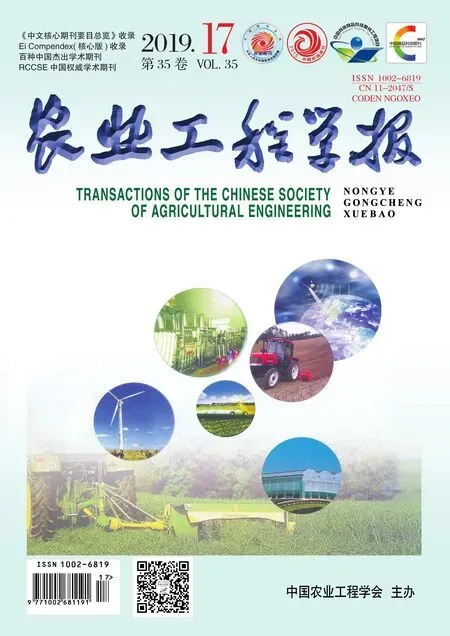生物炭对东北黑土持水特性的影响
王忠江,刘 卓,曹 振,李一博,张 正,王丽丽
生物炭对东北黑土持水特性的影响
王忠江1,2,刘 卓1,曹 振1,李一博1,张 正1,王丽丽1
(1. 东北农业大学工程学院,哈尔滨 150030;2. 寒地农业可再生资源利用技术与装备黑龙江省重点实验室,哈尔滨 150030)
为探究生物炭对东北黑土持水特性的影响,系统研究3种添加比例(2%、5%、10%)、3种粒径(0.25、0.5、1 mm)的杨木炭和竹炭对3种质地东北黑土(壤土、砂壤土、砂土)田间持水量和含水率的影响规律,构建添加生物炭黑土的水分特征曲线,并采用Van-Genuchten和Broods-Corey模型进行拟合。结果表明:生物炭能显著提高不同质地东北黑土的持水能力,黑土的田间持水量与生物炭的添加比例呈显著正相关,而与生物炭的粒径呈负相关,0.5 mm和1 mm粒径的生物炭对黑土田间持水量的影响差异不显著,杨木炭显著优于竹炭,0.25 mm、10%添加比例的杨木炭对东北黑土持水能力的提高效果最优,壤土、砂壤土、砂土3种质地黑土的田间持水量和饱和含水率分别可提高64.97%、66.42%、69.39%和47.60%、38.93%、31.18%;Van-Genuchten模型能更精确的模拟添加生物炭黑土的水分特征曲线,最佳离心时间为100 min,三次函数曲线能够较好的拟合添加生物炭黑土的体积含水率与离心吸力之间的多元动态关系,为生物炭对各种质地东北黑土水分运动规律的深入研究提供理论依据。
土壤;水分;生物炭;黑土;田间持水量;Van-Genuchten模型
0 引 言
中国东北黑土区是世界三大黑土带之一,总面积约103万km2,耕地面积29.67万km2,占全国耕地总面积的22.2%,其中黑龙江省占15.87万km2,是中国最大的商品粮供应基地和绿色食品生产基地,每年粮食作物商品化率达87.6%,素有中国粮仓之称[1-2]。然而,随着多年不合理的开发及过度的依赖化肥、农药等,黑土的结构破坏明显,持水能力和有机质含量逐年降低,水土流失严重,地力等级显著下降,使东北由“生态功能区”逐步转变为“生态脆弱区”[2]。截至2017年,黑龙江省水土流失面积达10.85万km2,占土地总面积的30%以上;近30 a来,黑龙江省坡耕地黑土层厚度由垦殖前的80~100 cm下降到20~30 cm[2],有机质含量由8%~10%下降到3%~4%[3],严重制约着黑土区农业水土资源的可持续利用及农业生态系统的健康发展,国家粮食安全也面临严重威胁。因此,加强黑土地保护和治理已刻不容缓。
在众多黑土改良措施中,生物炭在改善土壤形态结构、提高土壤持水能力和透水性、减少地表径流和水土流失、提升肥料利用率和作物产量方面更加安全、持久[3-8],成为近年来研究的热点。黑土持水能力的提高是表征其理化特性改善的重要指标之一,吴昱等[9-10]、魏永霞等[11-12]、姜佰文等[13]和王欢欢等[14]研究得出,生物炭能促进黑土团聚体的形成和黑土持水能力、水稳定性的提高。但土壤持水能力的提高依赖生物炭的类型、粒径、添加比例、土壤本身质地等多种因素。Tryon等[15]报道,木炭可显著增加林地棕色砂土的有效水含量,但却使棕色黏土的有效水含量下降。解倩等[16]发现,小于0.25 mm粒径大添加量的杂木炭可显著提高黄绵土的持水能力。而Wang等[17]得出,粒径为1~2 mm的胡桃木炭对砂土田间持水量的提高效果优于粒径小于1 mm的炭。Doerr等[18]认为,如果添加粒径过小的生物炭,土壤孔隙可能会被细小的炭颗粒堵塞而导致土壤入渗性能下降。土壤田间持水量和土壤水分特征曲线是表征土壤水分状态的重要参数和土壤水动力学特征的重要指标,且描述土壤水分特征曲线模型的普适性和精确度也依赖土壤类型[19]。因此,系统研究添加特定生物炭的不同质地东北黑土的田间持水量和水分特征曲线及模型的适应性具有重要意义。
本文系统研究杨木炭、竹炭的粒径、添加比例对壤土、砂壤土和砂土3种质地黑土的田间持水量和含水率的影响,拟合黑土水动力学模型,构建添加生物炭黑土的水分特征曲线,探究黑土的体积含水率与离心吸力之间的多元动态关系,为生物炭影响不同质地东北黑土水分运动规律的深入研究提供理论依据。
1 材料与方法
1.1 试验材料
试验所用壤土、砂壤土和砂土分别取自哈尔滨市东北农业大学试验田、大庆市大同镇农田和肇源县茂兴镇农田。取样深度为0~20 cm,过2 mm筛后密封备用。黑土的相关指标如表1所示。
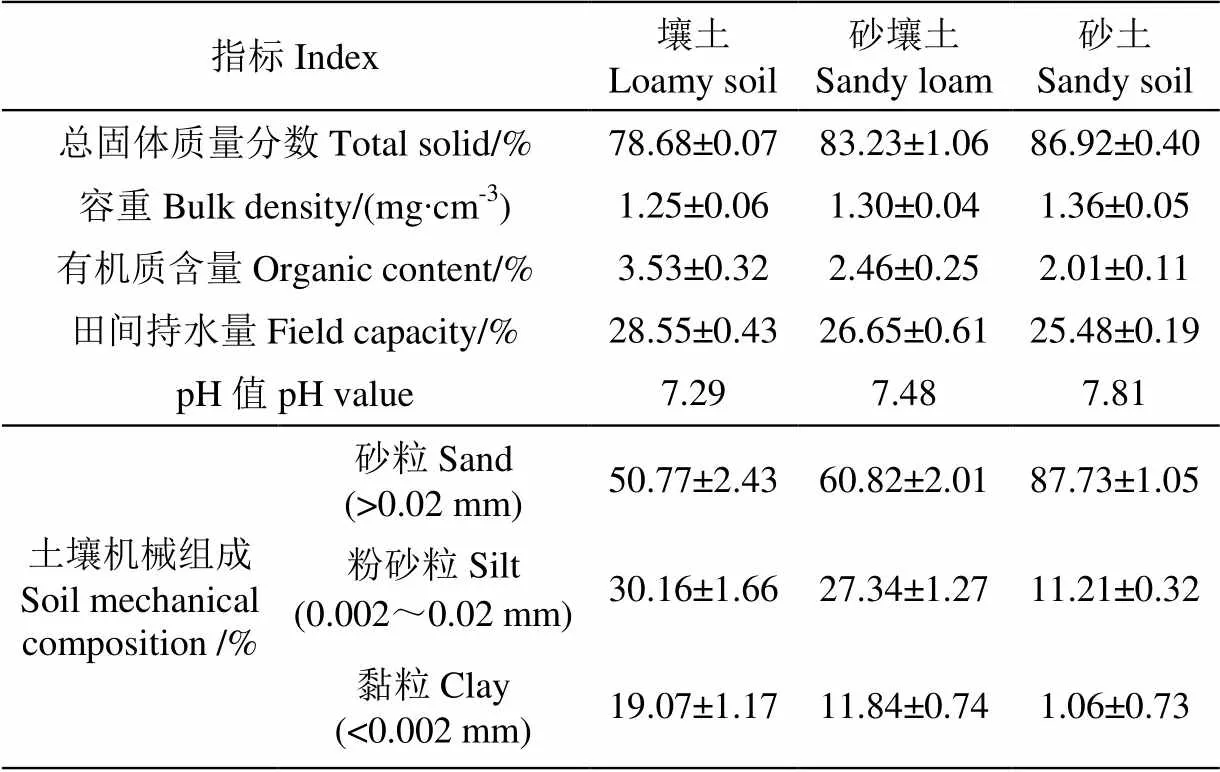
表1 黑土特性参数
试验所用杨木炭、竹炭购自武汉光谷蓝焰新能源股份有限公司,制备温度为620 ℃。两种生物炭均经研磨后分别过0.25、0.5和1 mm筛,再经105 ℃烘干后密封备用。生物炭的相关指标如表2所示。

表2 生物炭特性参数
1.2 试验设计
土壤田间持水量试验中,杨木炭和竹炭的粒径分别为0.25(C1)、0.5(C2)和1 mm(C3),添加比例分别为2%、5%和10%,每个处理3次重复。
土壤水分特征曲线试验中,生物炭的粒径和添加比例分别为0.25 mm和10%。离心吸力分别为20.57、82.28、329.12、740.52、1 316.48和2 057 cm,对应的离心转速分别为500(T1)、1 000(T2)、2 000(T3)、3 000(T4)、4 000(T5)和5 000 r/min(T6)。离心时间分别为20、40、60、80、100和120 min。未添加生物炭的空白纯黑土组分别为S1、S2、S3、S4、S5、S6,每个处理3次重复。
1.3 试验方法
土壤水分特征曲线采用离心法测定。按设定容重分层均匀装入17 mm×33 mm滤纸筒中,浸水饱和24 h,置入装有吸水材料的密封离心管后再放入恒温冷冻离心机(CR-21G,日本HITACHI公司)中,待离心结束土样达到平衡后,取土测定。
总固体含量采用(105±5)℃烘干法测定[20];土壤机械组成采用比重计法测定[21];土壤有机质含量采用烧失法测定[22];土壤田间持水量采用威尔科克斯法测定[23];土壤pH值采用电位法测定,土水比为1∶2.5[24];生物炭pH值采用GB/T7702.16—1997标准测定方法,炭水比为1∶10[25]。生物炭比表面积和平均孔径采用比表面积和微孔分析仪测定(JW-BK112T)。
1.4 模型方法
本研究采用Van-Genuchten(VG)和Broods- Corey(BC)2种模型,其中VG模型[26-27]适用土壤的质地范围较广,而BC模型[28]是常见的经验模型,形式均较简单,精度较高,便于推求土壤水分运动参数和描述土壤水分特征曲线[19]。
1)Van- Genuchten模型
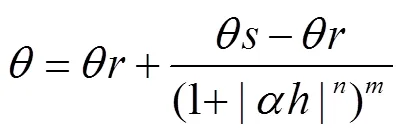
其中11(1)。
2)Broods-Corey 模型
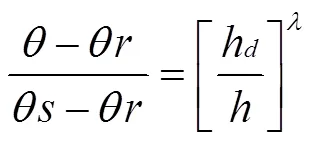
式中为土壤体积含水率,cm3/cm3;θ为土壤残余含水率,cm3/cm3;θ为土壤饱和含水率,cm3/cm3;h为土壤进气吸力,cm;为土壤吸力,cm;为拟合参数。
1.5 数据处理与分析
运用Retention Curve(RETC)软件拟合土壤水分特征曲线,运用SPSS20.0分析相关性、显著性及检验拟合效果。
2 结果分析与讨论
2.1 生物炭对黑土田间持水量的影响
添加生物炭黑土的田间持水量如图1所示。由图1可看出,不同质地黑土的田间持水量均随着杨木炭、竹炭添加比例的增加而显著增大(<0.01)。0.25、0.5、1 mm粒径杨木炭和竹炭的添加比例为10%时,壤土、砂壤土和砂土的C1杨、C2杨、C3杨与空白纯壤土、砂壤土和砂土相比依次增加64.97%、54.68%、54.82%,66.42%、58.09%、60.56%和69.39%、57.50%、63.30%,C1竹、C2竹、C3竹与空白纯壤土、砂壤土和砂土相比依次增加51.66%、40.74%、41.37%,61.54%、45.03%、43.68%和51.96%、39.13%、44.70%。C1杨各组显著高于C2杨和C3杨各组,而C2杨和C3杨差别较小,C1竹、C2竹和C3竹各组之间也表现出相同的规律,说明黑土的田间持水量与杨木炭和竹炭的粒径呈负相关,但不显著。杨木炭、竹炭的粒径为0.25 mm,添加比例为10%时,3种黑土的田间持水量最大,且杨木炭显著优于竹炭,添加杨木炭的壤土、砂壤土和砂土的田间持水量分别比添加竹炭的各组增加8.78%、3.02%和11.47%。同时,黑土本身的质地也直接影响其田间持水量的大小,空白纯壤土、砂壤土和砂土的田间持水量分别为28.55%、26.65%和25.48%。粉砂粒、粘粒含量与黑土田间持水量三者互为正相关,而砂粒含量与前三者均为负相关。除生物炭粒径为1 mm的各组外,添加杨木炭砂土试验组田间持水量的提高幅度大于添加杨木炭的砂壤土和壤土试验组,但添加竹炭的3种质地黑土田间持水量的提高幅度差异不显著。

注:C1杨-C3杨、C1竹-C3竹分别为添加杨木炭和竹炭活性炭的粒径0.25、0.5和1 mm。
Note: C1杨-C3杨werethe treatments with popular wood biochar and bamboo biochar size of 0.25, 0.5 and 1 mm, respectively.
图1 生物炭对黑土田间持水量的影响
Fig.1 Effects of biochars on field capacity of black soils
2.2 生物炭对黑土水分特征曲线的影响
添加杨木炭、竹炭黑土的水分特征曲线如图2和图3所示。
由图2和图3可看出,黑土的体积含水率均随着离心时间、离心吸力的增加而逐渐减小,且添加杨木炭、竹炭的黑土在各吸力下的体积含水率均高于空白纯黑土。添加杨木炭和竹炭的壤土、砂壤土、砂土的饱和含水率与空白纯壤土、砂壤土、砂土相比分别提高了47.60%、38.93%、31.18%和27.42%、21.76%、16.62%。添加竹炭黑土体积含水率的降低速度略低于添加杨木炭的黑土。添加杨木炭的壤土、砂壤土和砂土在离心80 min时,各离心吸力下的体积含水率与初始饱和含水率相比分别降低了24.84%~60.34%、25.14%~55.08%和28.21%~67.51%,在离心80~100 min时,分别降低了2.11%~8.20%、3.13%~7.64%和2.29%~11.04%;添加竹炭的壤土、砂壤土和砂土在离心100 min时,各离心吸力下的体积含水率与初始饱和含水率相比分别降低了27.87%~60.55%、27.97%~62.83%和35.42%~73.86%;100 min以后,添加杨木炭和竹炭黑土体积含水率的变化幅度均小于2%。

注:杨木炭生物炭的粒径和添加比例分别为0.25 mm和10%。T1杨-T6杨分别为离心转速分别为500、1 000、2 000、3 000、4 000和5 000 r/min 的处理。S1黑土-S5黑土分别为未添加生物炭的空白纯黑土对照。下同。

图3 竹炭对黑土水分特征曲线的影响
不同质地的黑土在不同离心吸力、不同离心时间条件下的体积含水率也均呈现壤土最大,砂壤土次之,砂土最小的规律。而且,对于同种质地的黑土,添加杨木炭各组的体积含水率显著高于添加竹炭的各组,该结果与黑土田间持水量的结果相一致。
2.3 黑土水分特征曲线的拟合
运用RETC软件拟合离心时间为100 min时黑土的体积含水率。空白纯黑土为CK组,添加杨木炭和竹炭的黑土分别为CY组和CZ组,VG模型和BC模型的拟合参数如表3所示。
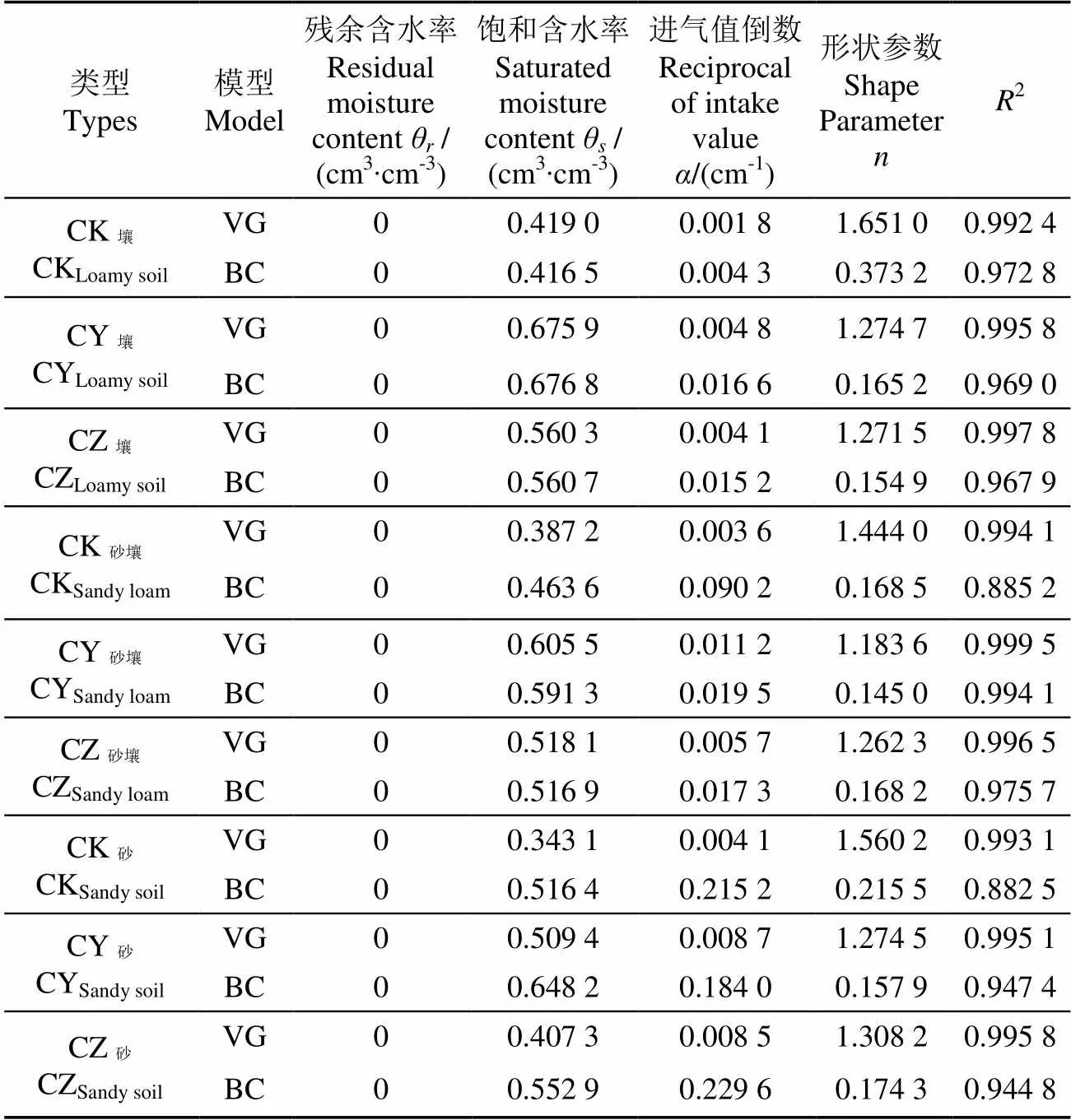
表3 黑土水分特征曲线VG模型和BC模型的拟合参数
由表3可看出,VG模型的拟合优度2均大于0.99,且明显大于BC模型的R,说明VG模型对添加杨木炭和竹炭的3种质地的东北黑土均适用,拟合度较好。因此,选用VG模型拟合3种质地黑土的水分特征曲线,并对拟合参数进行显著性分析,具体如图4和表4所示。
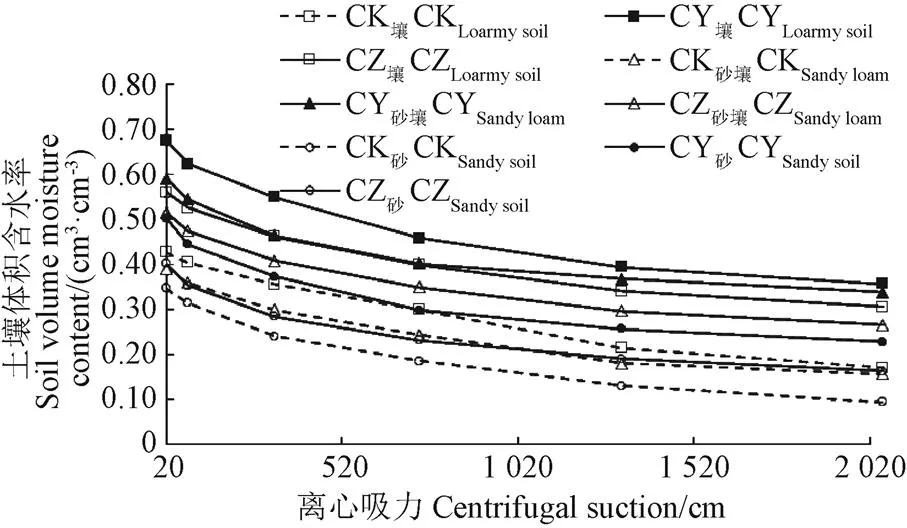
图4 离心100min时黑土的水分特征拟合曲线
由图4和表4可看出,离心100 min时土壤的水分特征拟合曲线与图2和图3中的实际结果类似,即在0~1 000 cm离心吸力范围内,黑土的体积含水率变化较大,而当离心吸力大于2 000 cm时,曲线逐渐平缓,无明显变化。添加杨木炭、竹炭黑土的饱和含水率和进气值倒数均高于空白纯黑土,同种质地的黑土比较时,添加杨木炭各组的饱和含水率和进气值倒数也均高于添加竹炭的各组,说明杨木炭提高黑土的持水能力更强,因为当进气值倒数越大,进气值越小,从黑土中排除的水越少,黑土的体积含水率则越大[29]。黑土的饱和含水率、进气值倒数与生物炭对黑土体积含水率的提高程度、生物炭的添加比例呈显著正相关,而形状参数与其呈显著负相关。离心100 min时各比较组的三次函数拟合曲线效果最好,拟合优度2均大于0.99,显著性水平为0.05,呈显著性相关,其回归方程如表5所示。
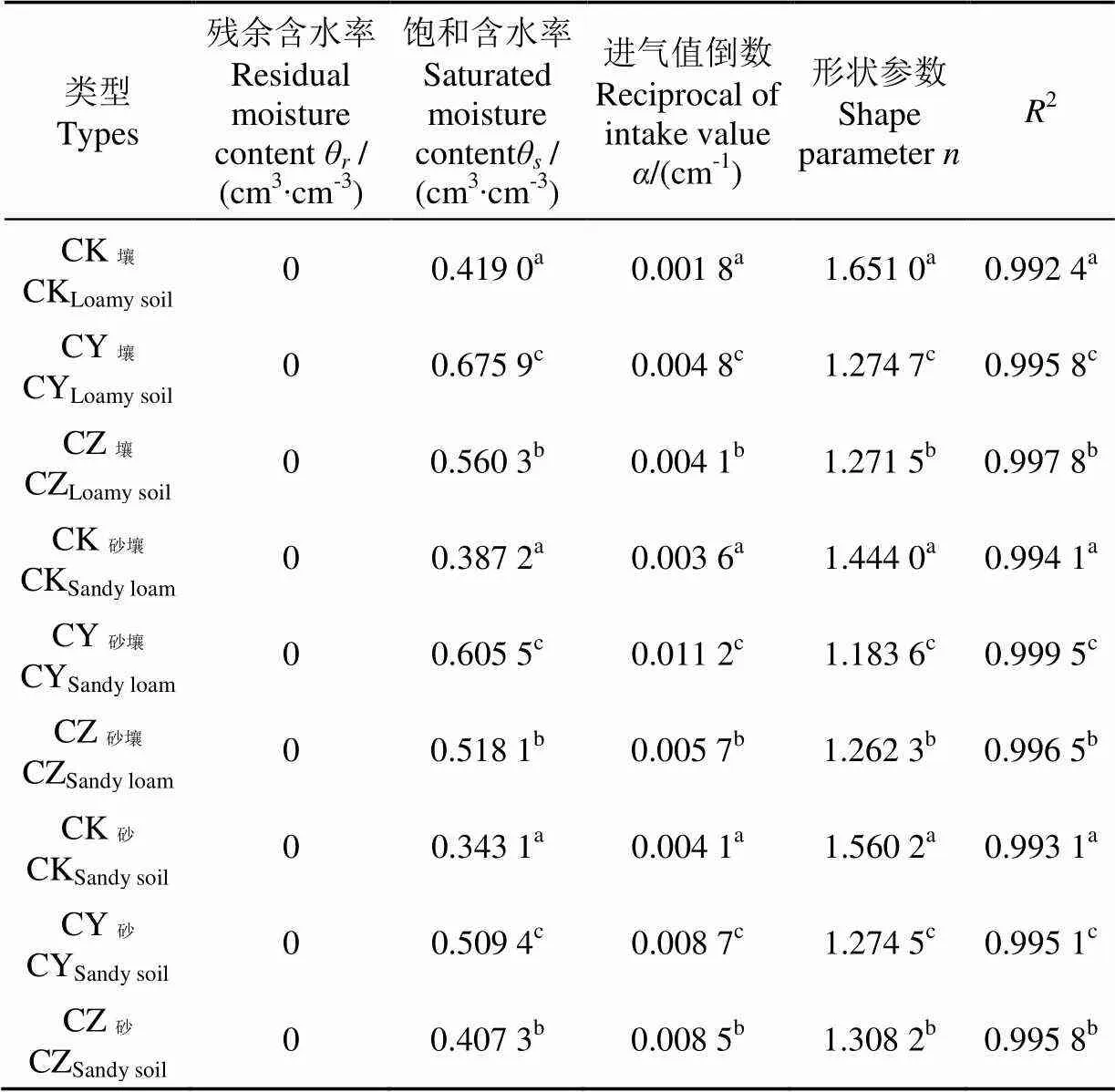
表4 VG模型拟合参数的显著性分析
注:a, b, c表示0.05水平显著。
Note: a, b, c show significant at 0.05.
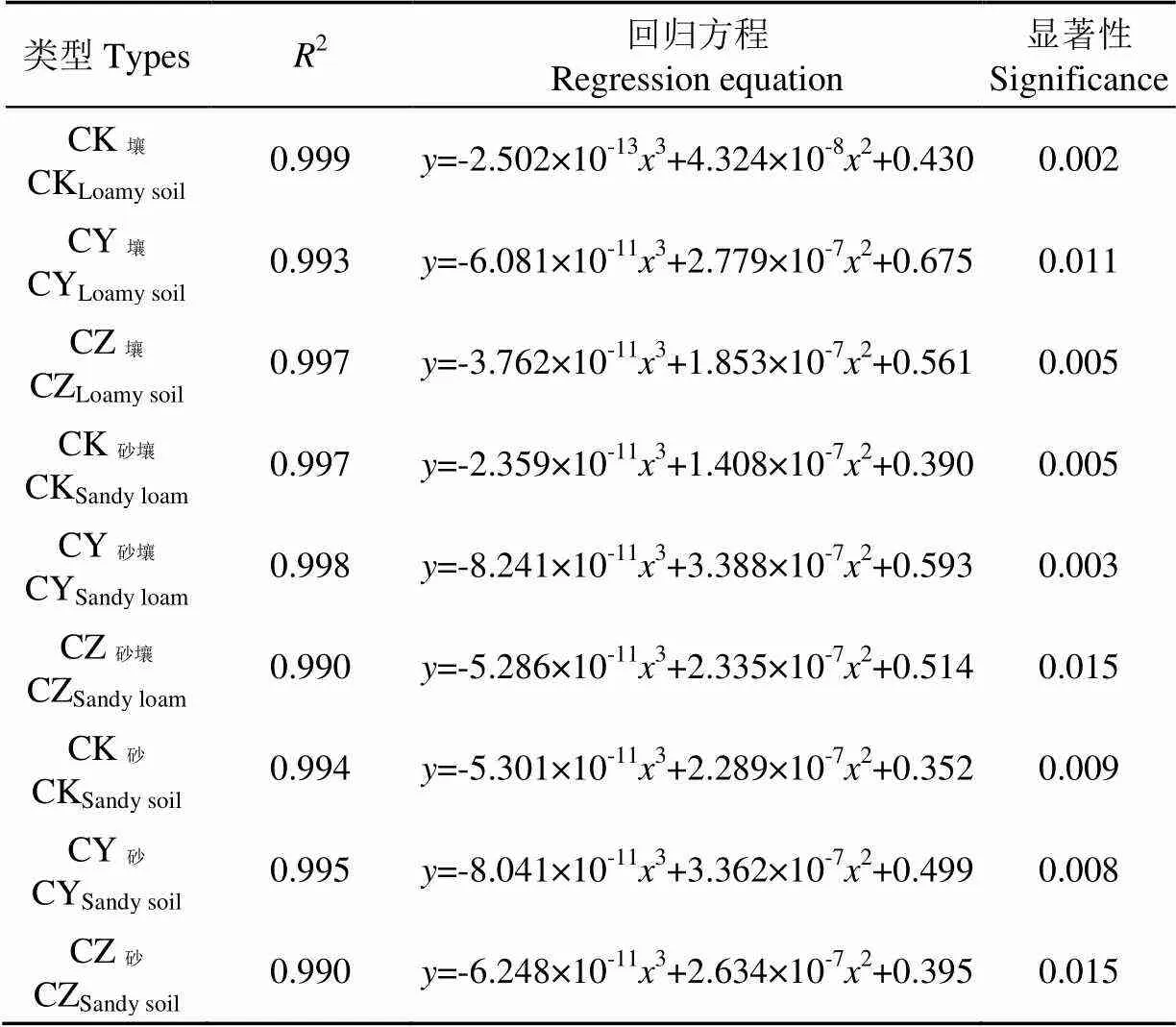
表5 回归方程
2.4 讨 论
不同质地黑土的田间持水量均随着生物炭添加比例的增加而增大,这是由于生物炭具有疏松多孔的结构,施入黑土后能够改善黑土团聚体的分布,进而提高黑土的持水能力[30],该结果与解倩等[16]针对黄绵土的研究结果相似。同时,小粒径的生物炭更有利于提高黑土的田间持水量,0.25 mm粒径的生物炭对黑土田间持水量的提高效果显著优于0.5和1 mm粒径的生物炭,而0.5和1 mm粒径生物炭的影响差异不显著。杨木炭的影响效果显著优于竹炭,这主要是由于杨木炭的比表面积为竹炭的14.6倍,平均孔径是竹炭的1/3,粒径越小,其比表面积越大,吸附能力和持水能力则越强[31]。本试验中,生物炭粒径为0.25 mm,添加比例为10%时,3种质地东北黑土的田间持水量最大。
土壤水分特征曲线受土壤类型、离心时间、离心吸力等多种因素的影响。添加生物炭的3种质地黑土的体积含水率均随着离心转速的增加和离心吸力的增大而逐渐降低。高吸力时黑土体积含水率的下降速度大于低吸力时,且离心时间越长,黑土的体积含水率越低,100 min的离心时间较优。对比分析VG模型和BC模型的模拟结果可知,VG模型更适于模拟添加生物炭的不同质地黑土的水分特征曲线。丁新原等[32]、王子龙等[19]比较VG模型和其他模型的土壤水分特征曲线的模拟结果也均得出VG模型模拟的精度最高。添加生物炭不同质地黑土的饱和含水率均高于空白纯黑土,且添加杨木炭的各组大于添加竹炭的各组,说明杨木炭提高黑土的持水能力更强,这与黑土田间持水量的结果相一致。
生物炭对黑土持水特性的影响与黑土本身的质地密切相关,壤土的田间持水量及在各吸力下的体积含水率均最高,其次是砂壤土,砂土最低,这是因为同质量黑土中壤土的黏粒含量最大,颗粒更细、比表面积更大,其本身的持水能力也好于砂壤土和砂土[20]。
3 结 论
1)不同质地黑土的田间持水量均随着生物炭添加比例的增加而显著增大,随着生物炭粒径的减小而增大,但不显著。生物炭粒径为0.25 mm,添加比例为10%时,黑土的田间持水量最大,杨木炭显著优于竹炭,添加杨木炭和竹炭的壤土、砂壤土、砂土的田间持水量与空白纯壤土、砂壤土、砂土相比分别提高了64.97%、66.42%、69.39%和51.66%、61.54%、51.96%。
2)杨木炭和竹炭均能显著提高黑土的饱和含水率,且杨木炭显著优于竹炭。离心法测定添加生物炭黑土的水分特征曲线的最佳离心时间为100 min;VG模型能够更精确的模拟黑土及添加生物炭黑土的水分特征曲线;三次函数曲线能够较好的拟合添加生物炭黑土的体积含水率与离心吸力之间的多元动态关系。
3)生物炭对黑土持水特性的影响与黑土本身的质地密切相关,黑土的田间持水量及在各离心吸力下的体积含水率与其砂粒含量呈显著负相关,而与其粉砂粒和粘粒含量呈显著正相关,无论是添加生物炭黑土,还是空白纯黑土,壤土的持水能力均最大,砂壤土次之,砂土最小。
[1] 李然嫣. 我国东北黑土区耕地利用与保护对策研究[D]. 北京:中国农业科学院,2017. Li Ranyan. Research on Policy Options in Utilizing and Protecting Farmland in Black Soil Region of Northeast China[D]. Beijing: Chinese Academy of Agricultural Sciences, 2017. (in Chinese with English abstract)
[2] 魏丹,匡恩俊,迟凤琴,等. 东北黑土资源现状与保护策略[J]. 黑龙江农业科学,2016(1):158-161. Wei Dan, Kuang Enjun, Chi Fengqin, et al. The present situation and protection strategy of black soil resources in northeast China[J]. Heilongjiang Agricultural Sciences, 2016(1): 158-161. (in Chinese with English abstract)
[3] 苏鹏,贾燕锋,曹馨月,等. 东北黑土区不同坡段等间距植物篱减流减沙特征[J]. 水土保持学报,2019,33(3):22-26. Su Peng, Jia Yanfeng, Cao Xinyue, et al. Characteristics of runoff and sediment reduction by equidistant hedgerows at different slope sections in northeast black soil area[J]. Journal of Soil and Water Conservation, 2019, 33(3): 22-26. (in Chinese with English abstract)
[4] 陈月明,裴隆翠,崔钢,等. 不同水土保持植被对典型黑土微团聚体稳定性的影响[J]. 东北林业大学学报,2019,47(6):26-30. Chen Yueming, Pei Longcui, Cui Gang, et al. Effect of soil and water conservation vegetation on the stability of micro-aggregates in typical black soil region[J]. Journal of Northeast for Forestry University, 2019, 47(6): 26-30. (in Chinese with English abstract)
[5] 牛晓乐,秦富仓,杨振奇,等. 黑土区坡耕地几种耕作措施水土保持效益研究[J]. 灌溉排水学报,2019,38(5):67-72. Niu Xiaole, Qin Fucang, Yang Zhenqi, et al. Efficacy of several tillages in conserving soil and water in slopping areas at the black soil in northwest China[J]. Journal of Irrigation and Drainage, 2019, 38(5): 67-72. (in Chinese with English abstract)
[6] Chan K Y, Van Z L, Meszaros I, et al. Using poultry litter biochars as soil amendments[J]. Australian Journal of Soil Research, 2008, 46: 437-444.
[7] Meng L L, Sun T, Li M Y, et al. Soil-applied biochar increases microbial diversity and wheat plant performance under herbicide fomesafen stress[J]. Ecotoxicology and Environmental Safety, 2019, 171: 75-83.
[8] Feng L, Li G T, Lin Q M, et al. Crop yield and soil properties in the first 3 years after biochar application to a calcareous soil[J]. Journal of Integrative Agriculture, 2014, 13: 525-532.
[9] 吴昱,赵雨森,刘慧. 不同的生物炭施用量和施用年限对土壤结构性指标的影响[J]. 水利科学与寒区工程,2019,2(3):5-11. Wu Yu, Zhao Yusen, Liu Hui. Effects on index of soil structure for amount and years of biochar apply[J]. Hydro Science and Cold Zone Engineering, 2019, 2(3): 5-11. (in Chinese with English abstract)
[10] 吴昱,刘慧,杨爱峥,等. 黑土区坡耕地施加生物炭对水土流失的影响[J]. 农业机械学报,2018,49(5):287-294. Wu Yu, Liu Hui, Yang Aizheng, et al. Influences of biochar supply on water and soil erosion in slopping farm-land of black soil region[J]. Transactions of the Chinese Society for Agricultural Machinery, 2018, 49(5): 287-294. (in Chinese with English abstract)
[11] 魏永霞,石国新,冯超,等. 黑土区坡耕地施加生物炭对土壤结构、肥力与大豆产量的影响[J/OL]. 农业机械学报, http: //kns. cnki. net/kcms/detail/11. 1964. S. 20 190 510. 1534. 002. html. Wei Yongxia, Shi Guoxin, Feng Chao, et al. Effects of applying biochar on soil structure, fertility and soybean yield on slope farmland in black soil region[J/OL]. Transactions of the Chinese Society for Agricultural Machinery. http: //kns. cnki. net/kcms/detail/11. 1964. S. 20 190510. 1534. 002. html. (in Chinese with English abstract)
[12] 魏永霞,王鹤,刘慧,等. 生物炭对黑土区土壤水分及其入渗性能的影响[J/OL]. 农业机械学报. http: //kns. cnki. net/kcms/detail/11. 1964. S. 20190605. 1031. 016. html. Wei Yongxia, Wang He, Liu Hui, et al. Effect of biochar on soil moisture and its infiltration performance in blacksoil area[J/OL]. Transactions of the Chinese Society for Agricultural Machinery. http: //kns. cnki. net/kcms/detail/11. 1964. S. 20190605. 1031. 016. html. (in Chinese with English abstract)
[13] 姜佰文,梁世鹏,张迪,等. 耕作与施肥对黑土团聚体粒级分布及水稳定性的影响[J/OL]. 东北农业大学学报,2019,50(7). http: //kns. cnki. net/kcms/ detail/ 23. 1391. S. 20190711. 1505. 010. html. Jiang Baiwen, Liang Shipeng, Zhang Di, et al. Effect of tillage and fertilization on particle size distribution and water stability of black soil aggregate[J/OL]. Journal of Northeast Agricultural University, 2019, 50(7). http: //kns. cnki. net/kcms/detail/23. 1391. S. 20190711. 1505. 010. html. (in Chinese with English abstract)
[14] 王欢欢,元野,任天宝,等. 生物炭对东北黑土理化性质影响研究[J]. 中国农学通报,2018,34(35):67-71. Wang Huanghuan, Yuan Ye, Ren Tianbao, et al. Influence of biochar on the physicochemical properties of black soil in northeast China[J]. Chinese Agricultural Science Bulletin, 2018, 34(35): 67-71. (in Chinese with English abstract)
[15] Tryon E H. Effect of charcoal on certain physical, chemical, and biological properties of forest soils[J]. Journal of Ecological Monographs, 1948, 18(1): 81-115.
[16] 解倩,王丽梅,齐瑞鹏,等. 生物炭对黄绵土水分入渗和持水性能的影响[J]. 地球环境学报,2016,7(1):65-76,86. Xie Qian, Wang Limei, Qi Ruipeng, et al. Effects of biochar on water infi ltration and water holding capacity of loessial soil[J]. Journal of Earth Environment, 2016, 7 (1): 65-76, 86. (in Chinese with English abstract)
[17] Wang D Y, Li C Y, Parikh S J, et al. Impact of biochar on water retention of two agricultural soils: A multi-scale analysis[J]. Geoderma, 2019, 340: 185-191.
[18] Doerr S H, Shakesby R A and Walsh R P D. Soil water repellency: its causes, characteristics and hydrogeomorphological significance[J]. Earth Science Reviews, 2000, 51(1/2/3/4): 33-65.
[19] 王子龙,常广义,姜秋香,等. 黑土区土壤水分特征曲线模拟及模型优选[J]. 东北农业大学学报,2018,49(9):36-43. Wang Zilong, Chang Guangyi, Jiang Qiuxiang, et al. Simulation and models optimization of soil water characteristic curve in black soil region[J]. Journal of Northeast Agricultural University, 2018, 49(9): 36-43. (in Chinese with English abstract)
[20] Wang L L, Wu J, Wang Z J, et al. Effects of three biochars as adsorbents on soils adsorbing ammonium nitrogen in biogas slurry[J/OL]. Journal of Chemistry, 2017, Article ID 4627928. http: // doi. org/10. 1155/2017/ 4627928
[21] 陈丽琼. 比重计法测定土壤颗粒组成的研究[J]. 环境科学导刊,2010,29(4):97-99. Chen Liqiong. Study on determination of soil particle composition by hydrometer[J]. Environmental Science Survey, 2010, 29(4): 97-99. (in Chinese with English abstract)
[22] Wang L L, Li W Z, Wang Z J, et al. Effects of digestate application depth on soil nitrogen volatilization and vertical distribution[J]. International Journal of Agricultural and Biological Engineering, 2016, 9(5): 101-107.
[23] 江培福,雷廷武,刘晓辉,等. 用毛细吸渗原理快速测量土壤田间持水量的研究[J]. 农业工程学报,2006,22(7):1-5. Jiang Peifu, Lei Tingwu, Liu Xiaohui, et al. Principles and experimental verification of capillary suction method for fast measurement of field capacity[J]. Transactions of the Chinese Society of Agricultural Engineering (Transactions of the CSAE), 2006, 22(7): 1-5. (in Chinese with English abstract)
[24] 李强,文唤成,胡彩荣. 土壤pH 值的测定国际国内方法差异研究[J]. 土壤,2007,39(3):488-491. Li Qiang, Wen Huancheng, Hu Cairong. Difference between international and domestic methods in determining soil pH[J]. Soils, 2007, 39(3): 488-491. (in Chinese with English abstract)
[25] 程桂芳. 煤质活性炭pH值测定方法的比较和建议[J]. 煤炭加工与综合利用,2014(5):45-47. Cheng Guifang. Comparison and suggestion on determination of pH value of coal-based activated carbon[J]. Coal Processing & Comprehensive Utilization, 2014(5): 45-47. (in Chinese with English abstract)
[26] Lu N, Dong Y.A closed-form equation for predicting the hydraulic conductivity of unsaturated soils[J]. Journal of Geotechnical and Geoenvironmental Engineering, 2015, 141(6): 892-898.
[27] Mualem Y. A new model for predicting the hydraulic conducticity of unsaturated porous media[J]. Water Resources Research, 1976, 12(3): 513-522.
[28] 来剑斌,王全九. 土壤水分特征曲线模型比较分析[J]. 水土保持学报,2003(1):137-140. Lai Jianbin, Wang Quanjiu. Comparison of soil water retention curve model[J]. Journal of Soil and Water Conservation, 2003(1): 137-140. (in Chinese with English abstract)
[29] 魏永霞,刘志凯,冯鼎锐,等. 生物炭对草甸黑土物理性质及雨后水分动态变化的影响[J]. 农业机械学报,2016,47(8):201-207. Wei Yongxia, Liu Zhikai, Feng Dingrui, et al. Influences of biochar on physical properties of meadow black soil and dynamic changes of soil water after individual rainfall[J]. Transactions of the Chinese Society for Agricultural Machinery, 2016, 47(8): 201-207. (in Chinese with English abstract)
[30] Mandal S, Thangarajan R, Bolan N S, et al. Biochar-induced concomitant decrease in ammonia volatilization and increase in nitrogen use efficiency by wheat[J]. Chemosphere, 2016, 142: 120-127.
[31] Lone A H, Najar G R, Ganie M A, et al. Biochar for sustainable soil health: A review of prospects and concerns[J]. Pedosphere, 2015, 25(5): 639-653.
[32] 丁新原,周智彬,雷加强,等. 塔里木沙漠公路防护林土壤水分特征曲线模型分析与比较[J]. 干旱区地理,2015,38(5):985-993. Ding Xinyuan, Zhou Zhibin, Lei Jiaqiang, et al. Analysis and comparison of models for soil water characteristic curves of Tarim Desert Highway Shelterbelt[J]. Arid Land Geography, 2015, 38(5): 985-993. (in Chinese with English abstract)
Effect of biochars on water retention properties of northeast region black soils
Wang Zhongjiang1,2, Liu Zhuo1, Cao Zhen1, Li Yibo1, Zhang Zheng1, Wang Lili1
(1.,,150030,;2.,150030)
The water retention capacities and organic matter content of valuable black soil is decreasing year by year with unreasonable farming and excessive dependence on chemical fertilizers and pesticides continuously. Black soil erosion is serious and black soil layer is less and less. It is urgent to protect black soil resource. Biochar is recognized gradually in recent years for improving soil structure, soil water retention capacity and crop yield, and for reducing surface runoff and soil erosion as a soil conditioner. However, most researches focus on the improvement in the acidic soil and sandy soil with less organic matter because of the high pH of biochar and the relative good fertility of black soil. The application of biochar in black soil in northeast region is relatively rare. The water retention capacity improvement is one of the important indexes to characterize the physical and chemical properties of black soil. In this paper, the effects of biochars including poplar wood carbon and bamboo carbon on the water retention properties of loamy soil, sandy loam and sandy soil were studied systematically with three different addition ratios (2%, 5%, 10%) and three different particle sizes (0.25, 0.5, 1 mm) of biochars. The water characteristic curves of different northeast black soils added with biochars were studied by the centrifugation method, and were fitted by the models of Van-Genuchten and Broods-Corey. The results showed that the field capacity and the saturated moisture content of loamy soil, sandy loam and sandy soil all increased significantly because of biochars addition. The field capacity of black soils increased significantly with the increase of addition ratios of biochars, but decreased with the increase of particle sizes of biochars. However, an insignificant difference in 0.5 and 1 mm particle sizes was achieved. The effects of poplar wood carbon on the water retention properties of black soils were superior to those of bamboo carbon, significantly. The particle size of 0.25 mm and addition ratio of 10% was optimum for poplar wood carbon to achieve high water retention capacities of northeast black soils. Under optimum condition, the field capacity and the saturated moisture content increased by 64.97% and 47.60% for loamy soil, 66.42% and 38.93% for sandy loam, and 69.39% and 31.18% for sandy soil, respectively. Furthermore, the effect of grain size distribution of black soil itself on its water retention properties was significant. A negative relationship was between soil field capacity and sand particle content of soil. However, the soil field capacity increased significantly with the increase of the silt and clay particle content of soil. Loamy soil has the largest water holding capacity, followed by sandy loam.The water holding capacity of sandy soil was the smallest. Moreover, the water characteristic curves of three black soils with biochar addition decreased gradually with thethe increase of centrifugal time and suction. Van-Genuchten model fitted the water characteristic curves of three black soils, more precisely. All the fit goodness of cubic curves simulating the relationship of soil volume moisture content and suction were more than 0.99. Centrifugation time of 100 min was optimum. The results in this study provided good insight into the effects of biochars on the water retention properties of different black soils in the northeast region.
soils; moisture; biochar; black soil; field capacity; Van-Genuchten model
2019-04-12
2019-08-25
国家自然科学基金项目(51406032)、中央引导地方科技发展专项(ZY17C05)、东北农业大学“学术骨干”项目(18XG15)
王忠江,教授,主要从事农业生物环境与能源工程研究。E-mail:neauwzj@126.com.
10.11975/j.issn.1002-6819.2019.17.018
S141.4
A
1002-6819(2019)-17-0147-07
王忠江,刘 卓,曹 振,李一博,张 正,王丽丽. 生物炭对东北黑土持水特性的影响[J]. 农业工程学报,2019,35(17):147-153. doi:10.11975/j.issn.1002-6819.2019.17.018 http://www.tcsae.org
Wang Zhongjiang, Liu Zhuo, Cao Zhen, Li Yibo, Zhang Zheng, Wang Lili. Effect of biochars on water retention properties of northeast region black soils[J]. Transactions of the Chinese Society of Agricultural Engineering (Transactions of the CSAE), 2019, 35(17): 147-153. (in Chinese with English abstract) doi:10.11975/j.issn.1002-6819.2019.17.018 http://www.tcsae.org

